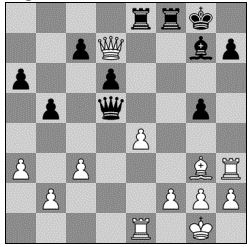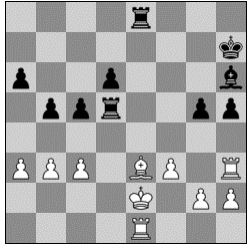Joy Cao (1138)
David Sigman (1346)
84th Massachusetts Open (4)
05.24.2015
Pirc (B08)
1. e4 d6 2. d4 Nf6 3. Nc3 g6 4. Nf3 Bg7 5. Bc4
Sort of a mix of lines. Usually with Bc4, white delays or omits Nf3 and plays Qe2. And of course 5. Be2 here is an old Karpov specialty.
5... O-O 6. O-O a6?!
Looks a bit out of place here - the tried and true tactic 6... Nxe4 7. Nxe4 (7. Bxf7+ Rxf7 8. Nxe4 h6 is also fine for black) 7... d5 8. Bd3 dxe4 9. Bxe4 Nd7 is about equal.
7. Re1
Going into "punish mode" with 7. e5!? looks tempting, after dxe5 (7... Ne8 8. Qe2) 8. dxe5 Qxd1 9. Rxd1 looks attractive, although 9… Ng4 10. Nd5 Nc6 may not be so bad for Black, due to the pressure on e5. For example: 11. Nxc7 Ra7 12. a4 Ngxe5 (or 12... b5!? which is quite messy). 7. Qe2 is a natural move which should be somewhat better for White.
7... b5 8. Bb3 Bb7 9. a3
Unnecessarily meek. 9. e5! is even stronger here when compared to the previous note: dxe5 10. dxe5 Qxd1 11. Rxd1 Ng4 12. e6!, now possible with the bishop on b7, seems unpleasant
9... Nc6
9... c5! is both natural and good
10. Nd5
10. e5 again looks strong
10... e6 11. Nxf6+ Bxf6 12. d5 Ne5
12... Na5! chasing the bishop and not worrying about the loss of a pawn looks fine for black: 13. dxe6 (13. Ba2 exd5 14. exd5 Re8 offers Black some counterplay) 13... Nxb3 14. exf7+ Rxf7 15. cxb3 Qd7 clearly offers excellent compensation due to open lines and two strong bishops.
13. dxe6
13. Nxe5 is a more precise order.
13... fxe6?
13... Nxf3+ 14. Qxf3 fxe6 15. Bxe6+ Kh8 appears to give more play for the pawn, and is similar to the game.
14. Bxe6+?
It's tempting to just grab the pawn, but the bishop on e6 looks merely strong. A knight appearing on that square, on the other hand, is a different story. Thus, 14. Nd4! is nearly decisive for white: Qe7 15. Nxe6 Rf7 16. Nf4 Nc4 17. Nd5 +-
14... Kg7 15. Nxe5 Bxe5 16. Qg4?
It's sometimes the case that after winning material, you begin to realize the position isn't all that great. This looks like one of those positions, and it's easy in such situations to lose your bearings and make an immediate error.
16. Bd5 offers to exchange a strong piece:
- 16... Bxd5!? is ambitious: 17. exd5 (17. Qxd5?? Bxh2+ 18. Kxh2 Qh4+ 19. Kg1 Qxf2+ and the rook is dropping with check) 17... Qf6 offers some compensation (17... Bxh2+ is a draw).
- Bxh2+ is an immediate perp: 17. Kxh2 Qh4+ 18. Kg1 Qxf2+ 19. Kh2 Qh4+
16... Bc8?
Very passive. There is no need to retreat a well-placed piece, and this also helps White solve the problem of poor piece coordination. 16... Qf6! makes things very awkward for White. Aside from the attack on f2 (and b2), the queen is tied to the defense of the problem e6 bishop: 17. Be3 (17. f3 might look normal, but 17… h5 18. Qh3 Rae8 19. Bb3 Bc8!-+ is now decisive.) 17... h5 18. Qh3 Rae8 and the counterattack is rolling.
17. Bxc8 Rxc8 18. Bg5 Qe8 19. c3 Qc6 20. Re3
The counterplay has dissapated, and white is now safely up a pawn. 20. f4!? looks even stronger, as Bf6 21. Bxf6+ forces Kxf6.
20... Qc5 21. Bh4
21. Qd7+ Kh8 22. Be7 Rg8 leaves Black seriously uncoordinated.
21... Rce8 22. Qd7+ Kg8 23. Rh3?!
Unless a move like this is connected to a knockout blow, it's not a great idea to put the rook out of play in this manner. It's possible that White decided against 23. Be7 due to Bxh2+ but 24. Kh1! +- spoils all the fun (if 24. Kxh2 Qe5+ 25. Kg1 Rxe7, Black regains the pawn with at least equal chances).
23... g5 24. Bg3
24. Bxg5?? loses immediately to Qxf2+ 25. Kh1 Qf1+. 24. b4 is a very clever inbetween move which the computer suggests. The very subtle idea is to deflect the queen away from access to e5. 24… Qb6 (24... Qc4 25. Bxg5 Qxe4 26. Bh6 Re7!? 27. Qxe7 Bxh2+ 28. Kxh2 Qxe7 29. Rg3+ Kh8 30. Bxf8 Qxf8 31. Re1 is also easily winning for white) 25. Rf1! gxh4 26. Rxh4 and black has no way to defend h7. If Bg7, then 27. Rg4+-. Finally, 24. Rf1 without b4 doesn't work: 24… gxh4 25. Rxh4 Bg7 26. Rg4 Qe5!
24... Bg7 25. Re1 Qd5!?

Quite an interesting and creative way to generate some counterplay. Aside from the fact the queen can't be taken, the idea is to stir up some trouble with ....Qd2.
26. Qg4 Qd2 27. f3 h6 28. Qd7 Rc8?
28... Qxb2! would have been the consistent follow-up. A somewhat forced variation is 29. Qxc7 Qxa3 30. Bxd6 Qxc3! 31. Qxc3 Bxc3 32. Bxf8 Bxe1 Here Black is losing all of his king-side pawns, but the 2 he has on the queenside look very fast: 33. Bxh6 b4 34. Bxg5 Bc3! (not 34... b3? 35. Bf6) and Black looks like he's close to winning
29. Qe6+ Kh7 30. Qb3 Rf6 31. Rb1!?
It's tempting to say..."A computer move!" Certainly not the first move to come to mind, but there is a clear idea of evicting the queen with Qd1. 31. Rd1 Qe2 32. Bf2 Rcf8 and the rook out of play on h3 continues to cause issues for White.
31... Rcf8 32. Qd1 Qe3+?
White's plan beginning with 31.Rb1!? looks very good now. 32... Qxd1+ 33. Rxd1 Re6 with the idea of ....g4 gives more play
33. Bf2 Qf4 34. Bg3 Qe3+ 35. Bf2 Qf4 36. Rg3!
White is absolutely correct playing on here.
36… c5 37. b3?
Having played the last series of moves very well, White starts to go wrong. It's difficult to say what plan this move puts in motion, as it mainly seems to weaken the queenside. 37. Rg4 would be the consistent continuation, and looks very good for White: 37… Qe5 38. h4! is very direct, but it gets the job done. 38. Bg3 Qe7 39. e5!? dxe5 40. Qc2+ Kh8 41. Re1 also looks nice.
37... Qe5 38. Rc1 h5 39. Qd5?
The exchange of queens hurts White now. After 39. Be3 g4 40. Qd3 White keeps a certain amount of control.
39... Qxd5 40. exd5 Bh6
Not bad, but the direct 40... Rf5 looks simpler. This also underscores the problem with 37.b3?, as the rook can't defend both d5 and c3 now (41. Rd1 Bxc3µ).
41. Be3 Rf5 42. Re1
42. Rd1 Re8, followed by either 43. Kf2 Rfe5 or 43. Bf2 Re2 (43... Bg7), gives the initiative to Black.
42... Re5 43. Kf2 Rxd5 44. Ke2?!
44. Bc1 gets out of the way of the potential pin on the e-file.
44... Re8 45. Rh3??

45. Kf1 Rd3 46. Bd2! is tricky, and it is White's best chance to save the game. 46… Rxe1+ 47. Kxe1 (47. Bxe1 Rd1-+) 47... d5 still leaves White with a tough defense ahead.
45... Rxe3+!
Very accurate, and winning. 45... g4? is the wrong order, as 46. fxg4 defends the bishop on e3.
46. Kxe3 g4+ 47. Ke4 Re5+!
The final precise move. Black is now just up a piece, and wins handily.
48. Kd3 gxh3
And now the ugly duckling rook on h3, stuck there since move 23, is gone! 48... Rxe1 49. Rxh5 gxf3 50. gxf3 Re3+ also wins.
49. Rxe5 dxe5 50. gxh3 Kg6 51. c4 Kf5 52. b4 cxb4 53. axb4 bxc4+ 54. Kxc4 Kf4 55. Kc5 Kxf3 56. Kb6 Be3+ 57. Kxa6 e4 58. b5 Bd4 59. b6 Bxb6 60. Kxb6 e3
0-1
This game was one of four winners of the annual Most Interesting Game prize at the Massachusetts Open, as selected by judge FM David Griego. A key match between two of the eventual top scorers in the Under 1500 section (Sigman finished tied for first with five points out of six, while Cao tied for sixth with 4/6 and a substantial rating boost), this is the first such highlighted match. Look out for the other winners throughout the issue.
|